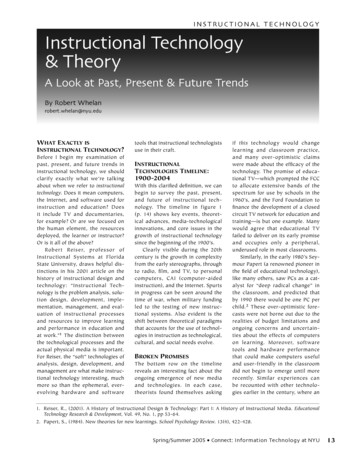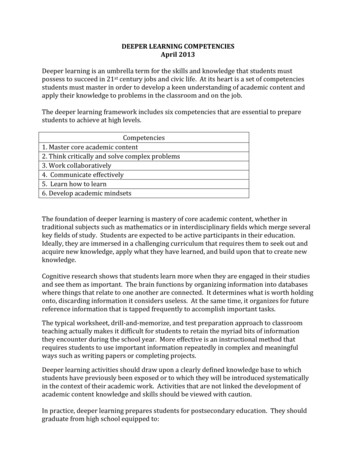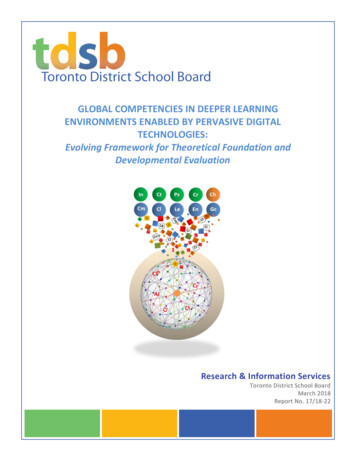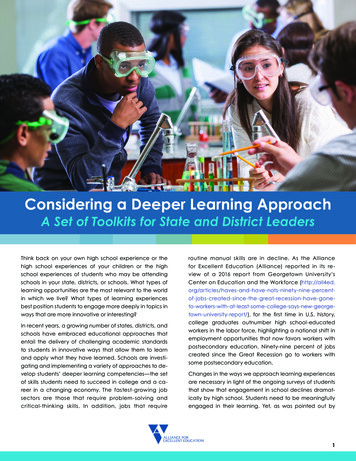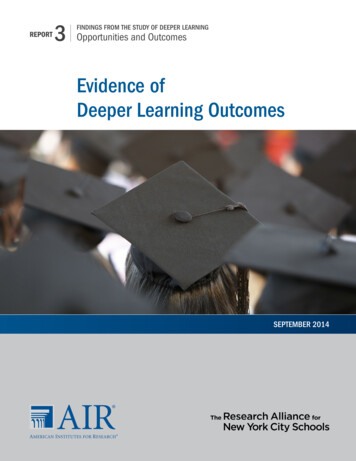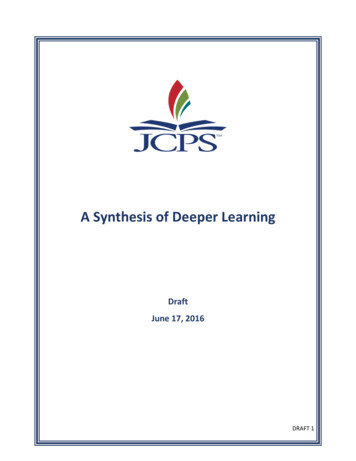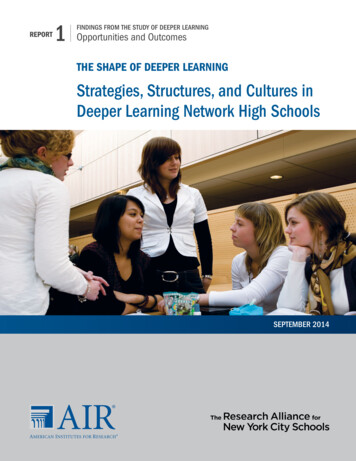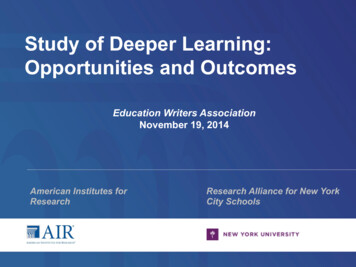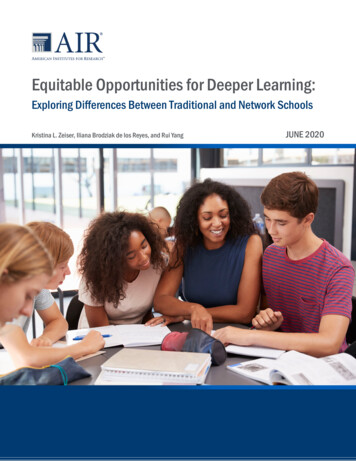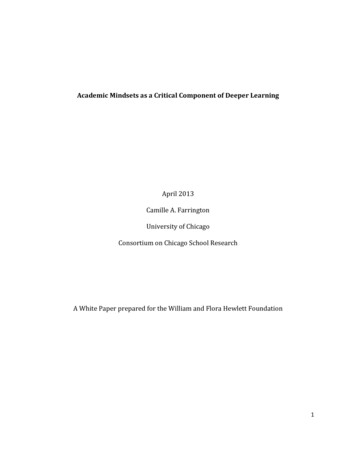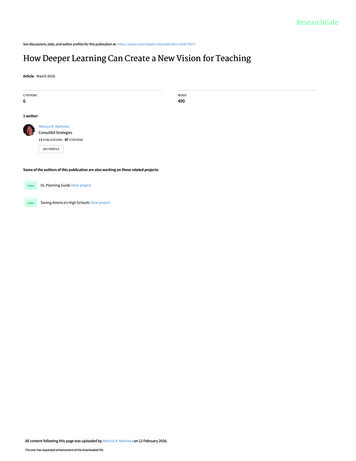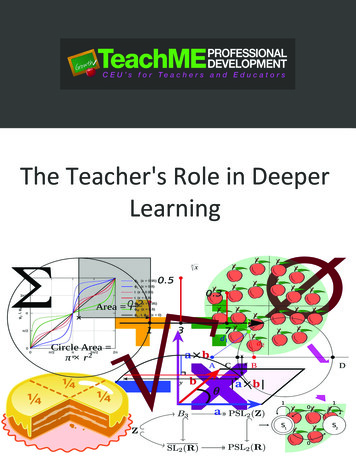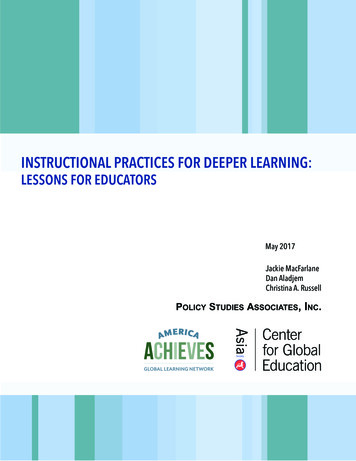
Transcription
INSTRUCTIONAL PRACTICES FOR DEEPER LEARNING:LESSONS FOR EDUCATORSMay 2017Jackie MacFarlaneDan AladjemChristina A. RussellPolicy StudieS ASSociAteS, inc.
Instructional Practices for Deeper Learning:Lessons for EducatorsIn just the past ten years, there has been a remarkable confluence of thinking about instruction and student learning in the UnitedStates and internationally. This new consensus emphasizes “mastering rigorous academic content, learning how to think criticallyand solve problems, working collaboratively, communicating effectively, directing one’s own learning, and developing an academicmindset.”1 This approach to teaching and learning, commonly referred to as “deeper learning,” has gained traction in recent years asresearchers and educators have come to recognize that today’s youth need to develop these competencies to access opportunitiesin the 21st-century global economy. A National Academies report drew attention to deeper learning, and a follow-up guide forpractitioners explored effective teaching approaches for deeper learning in the context of various subjects.2,3 Additionally, deeperlearning is reflected in rigorous standards such as the Common Core State Standards and the Next Generation Science Standards.The Program for International Student Assessment (PISA) is an international assessment that measures the reading, math, andscience skills of 15-year-old students.4 With its first administration in 2000, PISA provided a scientifically reliable and valid measureof deeper learning before the term gained widespread use. Specifically, PISA measures student attainment of critical thinking andproblem-solving skills in those three subject areas by the end of compulsory schooling. While PISA is designed to assess nationallevel outcomes and provide an international benchmark, school districts and schools in certain countries, including the United States,have been given the opportunity in recent years to participate in the PISA-based OECD Test for Schools as a way to obtain school-levelresults in order to inform school improvement.5America Achieves and the Center for Global Education at Asia Society support school systems in their efforts to improve performanceand contracted with Policy Studies Associates (PSA) to examine the instructional practices focusing on deeper learning skills indistricts and schools participating in the OECD Test for Schools or PISA. A research team from PSA conducted site visits to high schoolsin four school districts in the United States and Canada to learn about the instructional practices and strategies taken by educators topromote the deeper learning competencies addressed by the assessments.This summary brief is intended to provide practitioners with concrete strategies and practices for supporting instructionalimprovement efforts. It is split into three main sections: What can system-level leaders do to promote instruction focused on deeper learning? What can school leaders do to support instructional practices? What can teachers do to improve instructional practices?Each section is focused on what educators at each level of an education system can do to improve instructional practices. The goal isfor practitioners at the system, school, and classroom level to learn from the experiences of the districts and schools in the ds/2016/08/Deeper Learning Defined April s/groups/dbassesite/documents/webpage/dbasse uctional Practices for Deeper Learning: Lessons for Educators Summary Briefi
What Can System-Level Leaders Do to PromoteInstruction Focused on Deeper Learning?System-level leaders, including chief academic officers, assessment directors, directors of curricula andinstruction, and subject-area coordinators within a school district or larger local educational system canstrengthen instruction to promote deeper learning competencies through communication, collaboration,and providing support to schools and teachers.For instance, one school district used data from the OECD Test for Schools as the foundation forconversations and professional development around deeper learning instruction. The district used theresults from the assessment as a catalyst to engage high school leaders and provided an online learningmodule that helped school leadership teams better understand deeper learning competencies and guidediscussions in their schools.In another district, system leaders set policy to support schools in implementing deeper learning.Realizing the need for effective partnerships, the system issued a memorandum that called foreducators at all levels to collaborate around a shared understanding and commitment to students. Thememorandum encouraged relationship-building among education professionals and emphasized theimportance of all educators having a voice, sharing ideas, and communicating in order to achieve acommon vision for student success.The study also saw evidence of systems requiring or strongly encouraging that teachers have time forstructured collaboration and planning, so they can share challenges, align courses, develop assessments,receive feedback, and strategize innovative new ways to teach.System-level leaders can.Communicate a system-wide vision for instructional improvement by: Adopting a common framework or strategy that focuses on deeper learning competencies Clearly articulating the vision and plans for implementation of new instructional approaches Offering guidance and support to school leaders and teachers to help them understand the framework, competencies, andassociated practices Using data as the foundation for conversations and professional development around instructional practice and areas forimprovement Anticipating the time it will take for a system vision to translate to change in teacher practiceSupport teacher growth by: Ensuring that teachers have structured time to collaborate Encouraging various formats of common planning time, including grouping by: Subject and/or grades within a departmentCross-grades within a departmentGrade or cohortTransitional years (i.e., 8th and 9th grade) Providing coaches or other district-level support staff to schools Determining professional development opportunities based on the needs voiced by teachers and grounded in classroom practiceStrengthen system-level collaboration to support deeper learning by: iiBeing cognizant of existing silos within the systemPrioritizing collaboration and relationship-building between departments and divisionsPolicy Studies Associates, Inc.
What Can School Leaders Doto Support Instructional Practices?School-level leaders, including principals, assistant principals, department heads, and other teacherleaders, can support instructional practices through communication, collaboration, supporting teachers,data use, and technology.Many school leaders in the study grounded expectations in a common language, understanding, orframework so that all school staff shared a similar mission and approach to instruction. One schoolestablished a building-wide emphasis on problem-solving, and school administrators and teachersalike echoed the phrase “purpose plus autonomy equals mastery.” Other schools adopted practices thatwere embedded into the instructional culture of the school. For example, in one school, every teacherprominently displayed three questions in their classroom so that students had a reference point about thepurpose and objectives of each lesson: (1) what am I learning, (2) why am I learning it, and (3) how willI know I learned it? These strategies were simple and memorable so that all educators within the schoolshared a common understanding of instruction.School-level leaders can.Use data to drive instructional improvement by: Looking for trends and identifying the most pressing competencies to address Using data as leverage to take action Using evidence to prioritize instructional strategies for groups of studentsCommunicate a school-wide vision for instruction by: Identifying and articulating consistent expectations for instructional practices or strategies across the school Keeping the expectations simple and memorable Adopting a vetted framework or strategy for school-wide implementationSupport teacher growth by: Encouraging teachers to try new things Having teachers provide professional development to their colleagues Ensuring there are structures for school leaders to provide direct support to teachers, such as placing assistant principals and deansas instructional leaders Providing release time for teachers to co-plan and observe each other’s practiceMaximize technology to engage students in learning by: Budgeting and investing in technology Encouraging teachers to utilize computer-based resourcesCollaborate with feeder schools by: Establishing a relationship and sharing expectations Using data to inform discussions Providing transitional year teachers (i.e., 8th and 9th grade teachers) time to collaborate and visit each other’s classroomsInstructional Practices for Deeper Learning: Lessons for Educators Summary Briefiii
What Can Teachers Do toImprove Instructional Practices?Teachers can strengthen instruction to promote deeper learning competencies through continuouslyimproving their practice, challenging and engaging students in learning, and offering options andflexibility to all learners.Innovative teachers in the study improved their instructional practices by testing out new ways ofteaching. For instance, a high school Spanish teacher piloted a standards-based grading system basedon mastery of learning standards. The teacher emphasized the importance of students needing time formastery and allowing them to retake performance assessments until they mastered concepts adequately.Many teachers, especially English teachers, implemented thematic units that allowed students to explorea topic through different lenses and modes of learning, forms of expression, and experiences. For instance,one teacher planned an entire school year around the concept of heroism, anchoring each semester inone fictional work supplemented with non-fiction to provide a multitude of perspectives. The teacher alsoplanned a trip to a local museum to further explore the concept of unsung heroes.Some teachers also offered students options to showcase their learning, acknowledging the importanceof student choice. For example, one teacher gave students a comic strip assignment that incorporated keyterms and techniques of non-linear plots, including flash-back, flash-forward, foreshadowing, and dreaming.Students could choose to write their own story or retell a story they already knew, as well as which non-linearplot techniques to incorporate into their comic strip. They had the option to design their comic strip on paperor using a computer program.Teachers can.Review, revise, and improve their instructional practice by: Trying one new practice at a time; not taking on too many changes at once Being willing to learn alongside studentsChallenge and engage students by: Giving students time to think through answers and encouraging multiple responses Creating a safe learning space where struggling is encouraged Using current events and real-life examples to make learning more relevant by incorporating local and global perspectives intolearning Providing examples that are relatable to students and offering experiential learning opportunities Anchoring learning around themesDifferentiate instruction and offer flexibility for all learners by: Identifying barriers that students might encounter Approaching concepts through multiple modes of learning, including reading, writing, creating, and interacting Encouraging different approaches to problem-solving Giving students choices and options to demonstrate their learningivPolicy Studies Associates, Inc.
ContentsPageSummary BriefiIntroduction1What Can System-Level Leaders Do to Promote Instruction Focused on Deeper Learning?3What Can School Leaders Do to Support Instructional Practices?8Communicate a System-Wide Vision for Instructional ImprovementSupport Professional Planning and Growth for TeachersCollaborate Across Different Departments and Levels of the SystemUse Data to Drive Instructional ImprovementCommunicate a School-Wide Vision for InstructionSupport Professional Planning and Growth for TeachersMaximize Technology to Engage Students in LearningCollaborate with Feeder Schools to Ensure Continuity between School Levels35789111314What Can Teachers Do to Improve Instructional Practices?15Conclusion22References24Appendix A-Guiding Questions and Study MethodsA-1Review, Revise, and Improve Instructional PracticeChallenge and Engage StudentsDifferentiate Instruction and Offer Flexibility for All Learners151619
AcknowledgementsThis report was made possible through the generous support of the Kern Family Foundation and Bill and Melinda GatesFoundation. We would like to thank Elyse Rossi at America Achieves and Heather Singmaster at Asia Society for theircontinuous guidance and feedback. We would also like to express our sincerest gratitude to the district and school leadersand teachers who opened their buildings and classrooms to the research team and for their willingness to share theirpractices. Finally, we would like to thank Julie Meredith and Ben Lagueruela at PSA for their work on this report.
Instructional Practices for Deeper Learning:Lessons for EducatorsIn just the past ten years, there has been a remarkable confluence of thinking about instruction and student learning inthe United States and internationally. This new consensus emphasizes “mastering rigorous academic content, learninghow to think critically and solve problems, working collaboratively, communicating effectively, directing one’s ownlearning, and developing an academic mindset” (The William and Flora Hewlett Foundation, 2013). This approach toteaching and learning, commonly referred to as “deeper learning,” has gained traction in recent years as researchers andeducators have come to recognize that today’s youth need to develop these competencies to compete in the 21st-centuryglobal economy. A National Academies report drew attention to deeper learning, and a follow-up guide for practitionersexplored effective teaching approaches for deeper learning in the context of various subjects (Pellegrino & Hilton, 2012;The National Academies, n.d.). Additionally, deeper learning is reflected in rigorous standards such as the Common CoreState Standards (National Governors Association, 2010) and the Next Generation Science Standards (NGSS Lead States,2013).Overview of the OECD Test for Schools and PISAThe Organization for Economic Cooperation and Development(OECD) coordinates PISA, an international assessment thatmeasures 15-year-old students’ skills in reading, math,and science every three years (OECD, 2017). Specifically,PISA measures student attainment of critical thinking andproblem-solving skills in the three subject areas by the end ofcompulsory schooling. PISA scores provide national results thatparticipating countries use to make international comparisons.Results are given as mean scores and by proficiency levels thatcategorize performance.In the United States, individual districts and schools have theoption to participate in the PISA-based Test for Schools (knownas the OECD Test for Schools), which measures the samecompetencies as PISA (OECD, 2017). The OECD Test for Schoolsnot only provides schools with national and internationalbenchmarks for comparison, but also a comprehensive reportof their school’s data intended to guide school improvement.In contrast, schools participating in PISA both in the UnitedStates and internationally are not provided with school-levelinformation.School performance on the OECD Test for Schools is graphedas a function of socioeconomic background, so schools cansee how their performance compares to that of schools withsimilar socioeconomic backgrounds. In addition to providingsubject-specific data, the OECD Test for Schools asks students tocomplete a questionnaire about their attitudes and perceptionstowards school, learning, and relationships with school staff.The Program for International Student Assessment(PISA) is an international assessment that measuresthe reading, math, and science skills of 15-year-oldstudents. With its first administration in 2000,PISA provided a scientifically reliable and validmeasure of deeper learning before the term gainedwidespread use. Specifically, PISA measures studentattainment of critical thinking and problem-solvingskills in those three subject areas by the end ofcompulsory schooling. While PISA is designed toassess national-level outcomes and provide aninternational benchmark, school districts and schoolsin certain countries, including the United States,have been given the opportunity in recent years toparticipate in the PISA-based OECD Test for Schools asa way to obtain school-level results to inform schoolimprovement (see textbox for more details).America Achieves and the Center for Global Educationat Asia Society both support school systems in theirefforts to improve performance by incorporatinga global perspective. America Achieves facilitatesthe Global Learning Network (GLN), a professionallearning community for school and district leadersfrom world-leading schools that are committed toimproving education within their own systems andbeyond based on shared best practices. Asia Society’sCenter for Global Education partners with schools andschool systems to promote the incorporation of globalInstructional Practices for Deeper Learning: Lessons for Educators1
education into policy and practice, including through the Global Cities Education Network (GCEN), which convenes cityand education system leaders from the Asia-Pacific region and North America to share promising practices for addressingsystem-wide challenges in education.Under contract from America Achieves and Asia Society, researchers from Policy Studies Associates (PSA) examined theinstructional practices and school improvement efforts focusing on deeper learning skills in districts and schools that haveparticipated in the OECD Test for Schools or PISA. PSA conducted site visits to four school districts in the United States andCanada that were members of the GLN or GCEN to learn about the instructional practices and strategies taken by educatorsto promote the deeper learning competencies addressed by the assessments. The schools and systems selected for thestudy represented a range in performance on PISA or the OECD Test for Schools; however, all were attempting to makeimprovements, whether they ranked high or low. The research team visited the district office and two high schools in eachof these districts; they interviewed educators at every level of the system—within the district, schools, and classrooms, andconducted observations of high school classrooms (see Appendix A for a more detailed methodology). The research teamexplored the school- and system-level supports provided as well as the associated challenges encountered by educators atevery level.The goal of this report is to provide practitioners with concrete strategies–both big and small–for supporting instructionalimprovement efforts that target the deeper learning competencies that are at the heart of the OECD Test for Schools andPISA. The report is split into three main sections, focused on what educators at each level of an education system can doto improve instructional practices, to better understand the actions taken across the continuum of an education system. Itaddresses: What can system-level leaders do to promote instructi
promote the deeper learning competencies addressed by the assessments. This summary brief is intended to provide practitioners with concrete strategies and practices for supporting instructional improvement efforts. It is split into three main sections: What can system-level leaders do to promote
